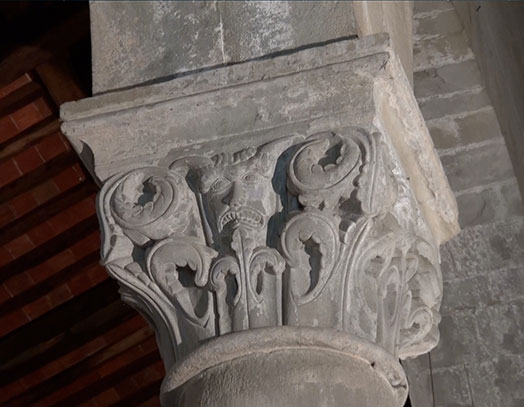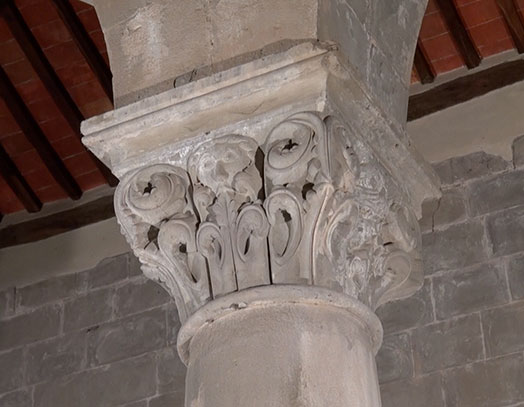THE CAPITAL of the GREEN MAN
left nave, second column
This Corinthian column also presents four figures, one on each side, and is not easy to interpret. Between the acanthus leaves appear the heads of: a devil (or, according to some, a satyr), a ram, a feline animal that also resembles a dragon, and finally a human face for which I am proposing a new identification. Monsignor Valente Moretti (2004) called this the capital of malefìcent evil-doers, or demons, of figures incarnating evil. The head facing the entrance, sometimes considered a satyr, probably does represent a demon, because a satyr is usually depicted with a goat’s beard and a grimacing animalistic smile, whereas here the expression is frightening, a devil frowning and showing his teeth. The ram is easily recognizable, whereas the feline can be identified as a lion, similar to the one on the next capital. Although in Christian symbolism the ram represents Christ as the leader of the herd, or else as a sacrifice, it is also the image of creative energy, generative force. The lion has an ambivalent significance: among its various aspects it might signify here the power and force of Christ or His power to free souls from the jaws of the lion, who in this case would be the devil in the form of a "roaring lion". However, here the ram also resembles a billy-goat, and in that case could be understood as another symbol of evil….
The last figure to be interpreted is that of a human face surrounded by acanthus leaves, out of whose mouth similar leaves appear to come. Usually, no explanations of this figure are given. I believe, however, that it contains the key to understanding this capital. I suggest that it be identified with what the Anglosaxons call the “Green Man”, a name which appeared for the first time in an article of 1939, The Green Man in Church Architecture, published by Lady Raglan in "The Folklore Journal", but which reveals the survival of a very ancient pagan cult of the springtime, the origin of which is lost in time and which is found in many cultures throughout the world, from ancient Rome to India – where it appears in the 8th century in the Temple of Rajasthan – from Germany and France to Indonesia, from England to Israel, with the “green men” of the Templar churches in Jerusalem (11th century).
The Green Man is a face surrounded by, or made out of, leaves, and shoots often sprout from his mouth, or also from his ears, nostrils and eyes, signifying the rebirth of vegetation in the spring. He is a very popular figure in the Anglosaxon world, appearing in all sorts of buildings and even on the signposts of pubs. In Italy it is much rarer: he appears, for instance, in the central portal of the Venetian Basilica of St. Mark (13th century). From the Renaissance on his function became predominantly decorative. In Italy there are some beautiful ones from the 1500s, ornaments on furniture or printed books, and he was “born again”, especially in the Victorian era, with the Gothic revival. Divinities connected to the Green Man include the Celtic Cernunnos and Viridios, the Latin Sylvanus, and mythical figures of the Celtic area such as Derg Corra, Jack o' the Green, Shakespeare’s Puck, up to such famous characters as Robin Hood, Peter Pan, and Sir Gawain (one of the knights of the Round Table), and even one unsuspectable figure, who according to some never existed: St. George the dragon slayer, who was also called “Green George” in Britain, the spirit of Spring. In Greek Georgios means "he who cultivates the land", therefore George signifies fertility and renewal.
But there are not only human and semi-human Green Man faces: there are “variations on the theme”, such as Green Cats or Green Lions, very popular in England in the 12th century, and with the adaptation of the pagan cult to the Christian religion Green Men begin to appear with the head of Christ (in the cathedral of Lincoln, Great Britain) or even the Madonna with Child (again in Great Britain, in the Lady Chapel di Ely). The capital in Gropina might actually represent some of these “variations”: the lion is almost like a Green Cat; the demon and the ram, each surrounded by acanthus leaves, seem to emerge from thick foliage, with other leaves nearby or coming out of their mouths. In addition, Gandolfo (2003) assigns this capital, along with the preceding one, dating both to circa 1170, to a stone-cutter trained in Provence (as did Roberto Salvini in 1966), and he sees the influence of his work in the cloister of Saint-Trophime (Arles), in the apse of the fortified church of Saintes-Maries-de-la-Mer, and in the cloister of the cathedral of Saint-Sauver in Aix-en-Provence. Since Provence is one of the areas where the Green Man is well known, as in the rest of France, this might confirm the presence of Provençal workers at Gropina, corroborated by stylistic elements.
Therefore there may be four Green Men “variations” depicted on this capital in Gropina: if the leaves do not come out of the mouth of the devil but only surround him, this happens in the case of many other Green Men. The symbolic significance is reinforced by their number: they do not testify to the survival of the pagan cult ("we are still here") but they are present as a warning against sin, or even, in a positive sense, professing the power of the Church to negate the inherently chthonic (subterranean) demonic powers: the idea of rebirth, symbolized by the Green Man, after paganism. It is not even to be excluded that this “rebirth” might have been understood in a Christian sense. Echoing this “positive” significance are the symbols of evil and sin: the devil (absolute evil), the lion (violence), the ram/billy-goat (the demonic) and the classical Green Man (the false religion, paganism), depicted to warn the Medieval man of the dangers to be avoided.
The choice between reading this “dark side” of the Green Man rather than the positive one of rebirth – of the union of man with the earth – fits in with the programmatic theme of salvation presented in the pieve of Gropina seen as a whole, even if an echo of its inherent original sense is not to be totally excluded either.


